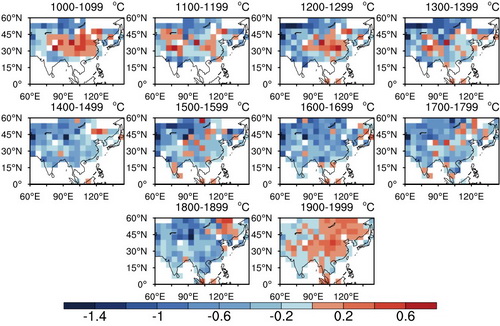A Multi-proxy Reconstruction of Spatial and Temporal Variations in Asian Summer Temperatures Over the Last MillenniumUpdate time:11 24, 2015
Reconstructions of the spatial and temporal patterns of regional temperature variability are important for a better understanding and quantification of the influence of different external forces and internal feedbacks of the global climate system at scales that are most relevant to human society. However, in many parts of the world, data on patterns of past temperature variability are sparse, on account of a paucity of proxy records. To solve this problem, the international Past Global Changes (PAGES) project established the PAGES 2k Network in 2009. This network includes the Asia 2k group, which mobilized the scientific community in Asia to obtain numerous proxy records that were not available from public data repositories. This effort produced temperature reconstructions and analyzed the spatial and temporal variability of reconstructed temperatures in Asia during the last ~2000 years. As a member of Asia 2k, Dr. SHI Feng from the Division of Cenozoic Geology and Environment, IGGCAS, with his co-authors reconstruct the spatial and temporal evolution of summer (June–July–August; JJA) temperature in eastern and south-central Asia using multi-proxy records and the regularized expectation maximization (RegEM) algorithm with truncated total least squares (TTLS), under a point-by-point regression (PPR) framework. The temperature field reconstructions illustrate that temperatures in central, eastern, and southern China during the 11th and 13th centuries, and in western Asia during the 12th century, were significantly higher than those in other regions, and comparable to levels in the 20th century. Except for the most recent warming, all identified warm events showed distinct regional expressions and none were uniform over the entire reconstruction area.
Figure. 1 Spatial patterns of summer temperature anomalies in Asia over the last millennium from the 11th to 20th centuries, with respect to AD 1961–1990.(Image by SHI et al.)
|
Contact
SHI Feng
Division: Cenozoic Geology and Environment Goup: Quaternary & environment Phone: 86-10-82998382 E-mail: shifeng@mail.iggcas.ac.cn Related Articles
Reference
|
-
SIMSSecondary Ion Mass Spectrometer Laboratory
-
MC-ICPMSMultiple-collector ICPMS Laboratory
-
EM & TEMElectron Microprobe and Transmission Electron Microscope Laboratory
-
SISolid Isotope Laboratory
-
StIStable Isotope Laboratory
-
RMPARock-Mineral Preparation and Analysis
-
AAH40Ar/39Ar & (U-Th)/He Laboratory
-
EMLElectron Microscopy Laboratory
-
USCLUranium Series Chronology Laboratory
-
SASeismic Array Laboratory
-
SEELaboratory of Space Environment Exploration Laboratory
-
PGPaleomagnetism and Geochronology Laboratory
-
BioMNSFrance-China Bio-mineralization and Nano-structure Laboratory

 Print
Print Close
Close

